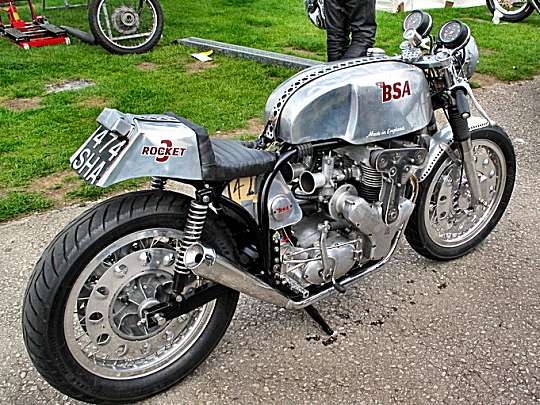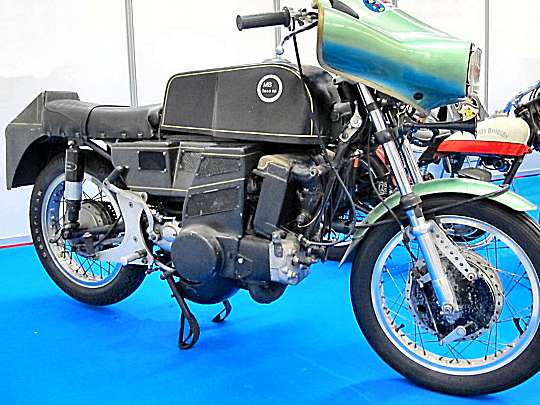Bitza Solos
The art of the bitza in all its splendour
(Part 2)
Let's complete this compilation of solo bitzas with a round-up of some of the more unusual machines, forming Part 2 of this unique collection.

NORBSA (Rocket 3) - Let's start with this two-wheeled masterpiece which proves that ingenuity really has no limits in the field of artisan mechanical creation.

NORBSA (Rocket 3) - A close-up reveals the subtle DOHC engine conversion providing the unique configuration of the power source for this machine. The clever engineer behind this fantastic motorcycle probably deserves a medal for his craftsmanship.

NORBSA - Another bitza born of the alliance between the two famous British brands. But this time, conversely, it's a BSA chassis and not a traditional Featherbed frame that houses a venerable Norton 500cc single cylinder.

NORFIELD - A perfect mechanical masterpiece with an aesthetic beauty to match. It would be difficult to better this remarkable machine as a cafe racer in the purest style of the 60s. The more observant amongst you and those connoisseurs of the British motorcycle industry will certainly recognise the 700cc OHV engine of the 1958 Constellation model.

NORBSA - Another unusual and remarkable achievement, photographed here at the International Norton Owners Association Rally organised in Lumby, Canada. A BSA A7 cycle hosting a Norton Commando engine complete with isolastic mounts.

It seems here that we may be dealing with the love child of Mr Rudge and Miss Velocette?

NORTORIOUS - The name of this custom-built machine might lead one to think that it belongs to Conor McGregor, the Irish mixed martial artist whose moniker is 'The Notorious'. Actually, that's not the case, although the style and presentation of this machine is just as flamboyant as the Irish UFC fighter.

In a completely different genre, here's an American-Italian machine comprising a 1932 Indian chassis powered by a customised Moto Guzzi Ambassador engine.

GORDIBSA - The inventive creators of bitzas don't just build machines exclusively from parts from other motorcycles. Some of them don't hesitate to borrow pieces from the auto industry, giving birth to inconceivable monsters! An example is this ancestral BSA chassis mated with a Renault Gordini 850cc OHV engine.

GORDIBSA - A close-up of the engine gives a better view of this famous racing engine designed in the 1960s by the Italian designer Amedee Gordini, known as 'The Wizard' for the Renault Dauphine model.

Another original bitza powered by a Renault car engine.

SAABSA - This machine was built in 1975 by combining the chassis from a BSA Rocket III with the 841cc triple out of a Saab 96. To make everything work together, its creator used a Triumph primary case, clutch and transmission, Vincent primary chain and sprockets, and a modified Morris Minor radiator.

SAABSA - A better view of the 3cyl 2 stroke watercooled Saab engine. It is said that its American creator, a certain Ray Pye, dissatisfied with his BSA Rocket III decided to change its original engine and replace it with the Swedish one.

NORNSU - Let's finish this lively bitza compilation with this NSU motor powered hybrid mounted in a Norton Commando chassis and photographed here at a meeting on the Zandvoort circuit in 1977.

NORNSU - A close up on the 4-cylinder NSU engine.
The archives of motorcycling ably demonstrate the unbounded enthusiasm of the motorcycling fraternity to customise and indeed personalise their machines. This desire stretches right back to some of the earlier riders, around the 1920s, who were keen to replace their engines with more powerful models.
However, the art of creating a machine from scratch using various diverse parts must be attributed to Britain. From the outset, the basic components usually comprised a British brand chassis coupled with a British brand engine, (or vice versa); the mix of brands being fairly limited at that time.
But as this compilation of enigmatic bitzas so clearly shows, the practice has of course evolved over time. The imagination of the designer has no limits. It only takes an idea, a workshop, tools, financial resources, and of course a talented mechanic, with enough free time to create something unique and very often a reflection of the rider themselves.
- Jean-Francois Helias
To complete this interesting compilation of solo bitzas, here are two more based on 3 cylinder DKW engines.
The first, built in 1968 and 'christened' Michel Borie 1000 SP, is the work of Michel Borie the son of the French importer of the Harley Davidson Aermacchi brand at the time.
What distinguishes this bitza from other similar machines is the horizontal position of the 3-cylinder D.K.W. which is 'hooked' by the cylinder head. In this horizontal position the motor provides much better thermo-siphon cooling, also enabling the radiator to be reduced in size by 40%.

Michel Borie 1000 SP (1968) - The Norton chassis houses a car engine from a DKW, 3-cylinder 2-stroke engine. The 4-speed gearbox was borrowed from a BSA A10 twin. At the front, the telescopic fork is a Ceriani and the brake an Oldani twin leading shoe drum identical to that of the Aermacchi factory motorcycles
Another peculiarity of the M.B. is that it is asymmetrical when seen from the front. In order to obtain an alignment of the primary and secondary transmission chains, the engine has been offset to the right, perhaps to the detriment of the road holding. However, this is negated by slightlyre-positioning the radiator to the left as well as offsetting one or two other parts, especially the fairly heavy primary transmission casing.

Michel Borie 1000 SP (1968) – The transverse tube joining the two tie rods of the cylinder head was intended for fixing a lower fairing. An option not retained because it is detrimental to the cooling
The idea of using a car engine to run a motorcycle dates back to the time of the very first wizard-mechanics. They began to installing two or three-cylinder type De Dion, Anzani, Buchet, and Aster originally intended to power a car.
Closer to the present day, this 3 cylinder DKW auto engine has often been chosen by bitza builders to propel their creations. Born in the 1930s, it saw three decades of service undergoing various transformations. Originally 900cc then 1000, it offered a torque then unknown on a conventional motorcycle engine of around 50hp.

In a much less aesthetic and sophisticated version, another solo DKW bitza; the "jampot" suspension suggest that the chassis is likely to be that of an AJS or Matchless.
- Gilles Gaudechoux